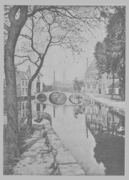Finalizing a chapter on the city novel as genre – what distinguishes the city novel?
Drawing on Daniel Acke, Burton Pike, Hana Wirth-Nesher, Bart Keunen, and others – one important reference point is also the preface to Rodenbach’s Bruges-la-morte:
“Voilà ce que nous avons souhaité de suggérer: la Ville orientant une action; ses paysages urbains, non plus seulement comme des toiles de fond, comme des thèmes descriptifs un peu arbitrairement choisis, mais liés à l’événement même du livre.”
Rodenbach, Georges 1892/1903: Bruges-la-Morte. Translated by Thomas Duncan. London: Swan Sonnenschein & co.
Not the city as character, then (although Rodenbach refers to that, too), but the city as presence and influence.

